Briefly about heating meters: installation sites,
The mode of operation of an autonomous heating system is easy to set yourself, as well as take into account the cost of purchasing energy. But the quality of heating of urban housing leaves much to be desired, and payment for the services provided is charged regularly and in full. Therefore, an increasing number of people are installing meters for heating in an apartment, which allow for more accurate accounting of the heat energy received and its cost.
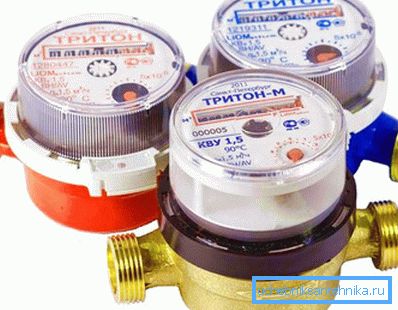
Installation sites of metering devices
The economic benefit that the meter gives in the apartment is obvious. Using it, you will pay not just heating services, but the amount of heat energy entering the apartment. After all, it is not a secret for anyone that often utilities do not adhere to standards, and the temperature in houses drops below a set level.

Tip! The effect will be even greater if the meter for heating is installed after you use your own hands or with the help of a hired team of builders to take measures to reduce heat loss. Change the window blocks to airtight, make wall insulation and so on.
The instruction governing the installation of metering devices provides two places where they can be installed:
- on the central collector of the house - in this case the services rendered to inhabitants of all apartments connected to the riser will be taken into account;
- on individual inlets - here the apartment heating meter will count your own heat expenses, which should be paid for.
Accounting for general house expenses
The easiest and most inexpensive way is to install a metering device in the basement, on the main riser that supplies coolant to the apartments. In this case, the device, the price of which is quite high, will be bought in bulk and will not cause irreparable damage to the family budget.
Before you pay for heating services, you need to take readings of the device and divide them into all tenants, taking into account the area of the apartments. If the invoices issued by the operating organization do not coincide with the data obtained as a result of the calculations, it is possible to compel the unscrupulous supplier to return the money transferred earlier.
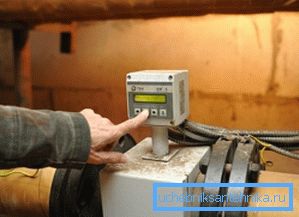
Common meters for heating can be installed with the consent of all residents of the house or the entrance. The decision must be secured by protocol. Only in this way it will be legitimate. On the basis of this document, you should contact the relevant authorities for obtaining permission to install a public meter.
Accounting for individual costs
The above option has several drawbacks.
In particular, this device will count not only the heat energy supplied to your apartment, but also the heat loss that occurs:
- in insufficiently insulated main pipes passing through basements and technical floors;
- in a cold staircase;
- in apartments of unscrupulous tenants who are not taking measures to increase the energy efficiency of dwellings.

Considering the above, it is desirable to still put the meter on the heating in the apartment. Although you will have to spend significantly more money on this, you will undoubtedly feel an economic result when the heating bills decrease.
But in this case, you will have to face certain difficulties:
- In apartment buildings of the old building used a vertical wiring diagram of heating pipes. This means that a separate pipe coming from the neighbors is suitable for each radiator. Consequently, it is necessary and the same number of accounting devices, which is absolutely not profitable. To solve the problem will help the heating meters in the apartment, which are installed directly on the radiators. But the installation of such devices must be coordinated with the operating office, since their readings may not be used everywhere to account for the received heat.
- You can also fix the amount of heat energy received in flats with vertical wiring using the distributors. They calculate the volume and quality of the incoming coolant based on the temperature difference between the surface of the battery and the air in the room.

- The easiest option is to install a general home meter.. This option was discussed in detail in the previous section.
As for the more modern houses, in them the coolant flows through a horizontal pipe, fed from a vertical riser. In this case, you can easily arrange heating by the meter. Just buy the type of metering device you like.
Varieties of heat meters
Mechanical
Their design is the simplest.
There are three main varieties:
- screw;
- turbine;
- with impeller.

Let us see how the heating meter works: in mechanical devices, the measuring scale is set in motion by the coolant current. The passing liquid turns this or that mechanism.
Devices are most accessible, but have some features:
- Cannot be used if hard water flows through the pipes.
- Very sensitive to the physical purity of the coolant. Particles of debris, scale and scale can break the mechanism of the meter, which is beyond repair.
- The device incorrectly takes into account the flow, if sharp fluctuations in fluid pressure occur in the flow pipe.
Tip! If you decide to use a mechanical heat meter, it is advisable to install a strainer at the inlet of the heating system (up to the installation site of the device) that traps solid particles in the coolant.
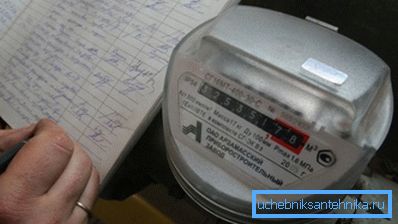
Electromagnetic
These devices use the principle of electromagnetic induction - the appearance of electricity when a fluid passes in a magnetic field. Meters do not contact directly with water and provide accurate metering.
But there are some minor flaws:
- Electromagnetic counter must be properly installed and connected;
- If the coolant contains a large amount of impurities, the readings may not correspond to the amount of heat energy supplied.

Whirling
The device takes into account the amount of coolant used on the basis of turbulent eddies, which are formed behind a specially placed obstacle in the path of the fluid. Such a device can be installed on both horizontal and vertical pipes.
The following circumstances affect the accuracy of accounting:
- quality of flowing water;
- welding works that are performed in the heating network;
- the presence of air in the pipelines.
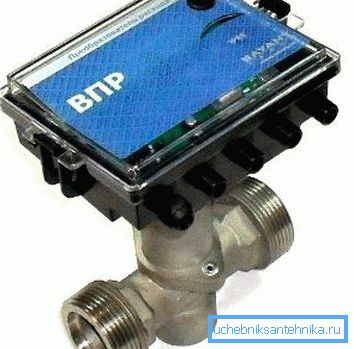
It should also be noted that mineral impurities and chemical elements dissolved in water do not adversely affect the devices. And you can get rid of other troubles with the help of a mesh filter with a magnet, which is mounted on the incoming pipe.
Note! For the flowmeter to work correctly, it is necessary that there be a straight section of the pipeline of a certain length in front of it. It depends on the heat meter model and is listed in the accompanying documentation.
Ultrasound
The metering device operating on the ultrasonic principle consists of a source and receiver of signals. It measures the time during which a fluid travels a previously known distance and, on the basis of this, calculates its volume and flow rate.
There are the following types of these devices:
- Doppler;
- temporary;
- frequency;
- correlation.
Despite the greatest reliability, accuracy and durability, the ultrasonic meter is very sensitive to the purity of the coolant. In addition, the presence or absence of air in the fluid affects the accuracy of the account.

General requirements
Regardless of the flow meter model, each metering device must meet the following requirements:
- Have a certificate and passport, which notes information about the installation and periodic verification.
- Have a stamp or seal indicating that no changes have been made to its design.
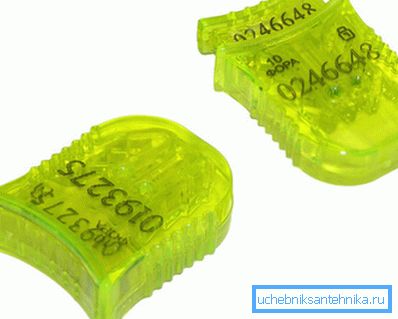
Installation of heat meters
Stages of work
It should be noted that the main difficulty that a person who wants to install a heat metering device may encounter is not the purchase and installation itself, but the procedures related to obtaining the necessary permits.
In most cases, you will have to go through the following steps:
- apply and receive documents that are the basis for installing a heating meter;
- develop an engineering project in which the installation sites, names of devices, their number and other important information are indicated;
- coordinate this document with regulatory organizations;
- install the device on site (this can only be done by a specialized organization);
- register the installed device, check it, seal it and register it with the organization that is responsible for heating apartment buildings.

The longest in time will be the first stage. Although recently it has become more loyal to installing individual steel meters, it is sometimes quite difficult to get permission. Indeed, in this case, the obligation to pay unproductive heat loss does not fall on you, but on the supplier, which, naturally, the leadership of the latter does not like.
Anyway, to obtain permission, the following documents should be prepared:
- Statement of your decision to purchase and install a heat meter.
- Documents confirming the ownership of the dwelling where the installation will be carried out.
- Technical passport for an apartment with engineering networks marked in it.
- Papers confirming the consent of the other owners of the apartment to install a heat meter.
Once this is done, you can begin to draw up technical documentation.
Engineering Project Preparation
This document is developed taking into account the technical data provided by the organization that deals with heating of apartment buildings.
They may also have individual requirements, but, according to the current SNiP, the project must contain:
- calculation of the heat load of installed radiators;
- the planned volume of consumption of the coolant;
- parameters of hydraulic resistance, which will provide the installed counter flow of the supplied fluid;
- connection scheme of accounting equipment to existing pipelines;
- calculation of the amount of heat loss that the meter cannot take into account;
- calculation method of payment for the consumed thermal energy.

At the end of the design document must pass approval.
Equipment installation
This stage can be started only after the project documentation has passed all stages of coordination.
Note! Self-insertion of the heat meter is not allowed. To carry out the work you need to invite a specialist who has the appropriate skills, confirmed by certificates or certificates.
During installation, ensure that the following requirements are met:
- Install the metering device can only be in the place that is provided by the project. If you decide to make any changes, they should be reconfirmed.
- The installation of a heat meter should be carried out outside the apartment (in a technical room or a storeroom) in order to ensure unhindered access to it by service organization specialists. In some cases, installation is allowed in the dwelling itself, however, in this case the issue is solved individually.
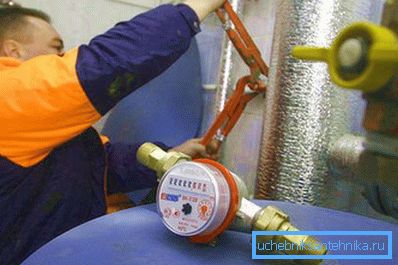
- Before and after the counter, it is imperative to provide for the presence of straight pipe sections (so-called “resting sections”). They eliminate turbulence coolant.
- The temperature sensor should be inserted into the pipe so that its sensitive area is exactly on the central axis of the flow of coolant. Only in this case, the testimony will be true.
- It is important to design the installation so that the water passing through this section does not form air bubbles that affect the correct operation of the heating meter.
Tip! It is also desirable to provide for the installation of valves. So you can dismantle the metering device without draining the coolant.
Registration Procedure
At the end of the installation, it is necessary to invite a specialist from the organization responsible for heating, who will verify the installation, seal the device and prepare documents authorizing its operation.
The acceptance commission should include:
- homeowner;
- representative of the company operating the apartment building (housing office, OSBB);
- representative of the company that provides heating services;
- specialist in installing equipment.

Based on the results, a statement is drawn up, which is the basis for paying bills according to the meter reading.
Conclusion
Installing a meter for heating is troublesome, costly and time consuming. But you will not be disappointed in the decision made when you transfer money for heating. For more information about ways to save on utility bills, you can learn from the video below.